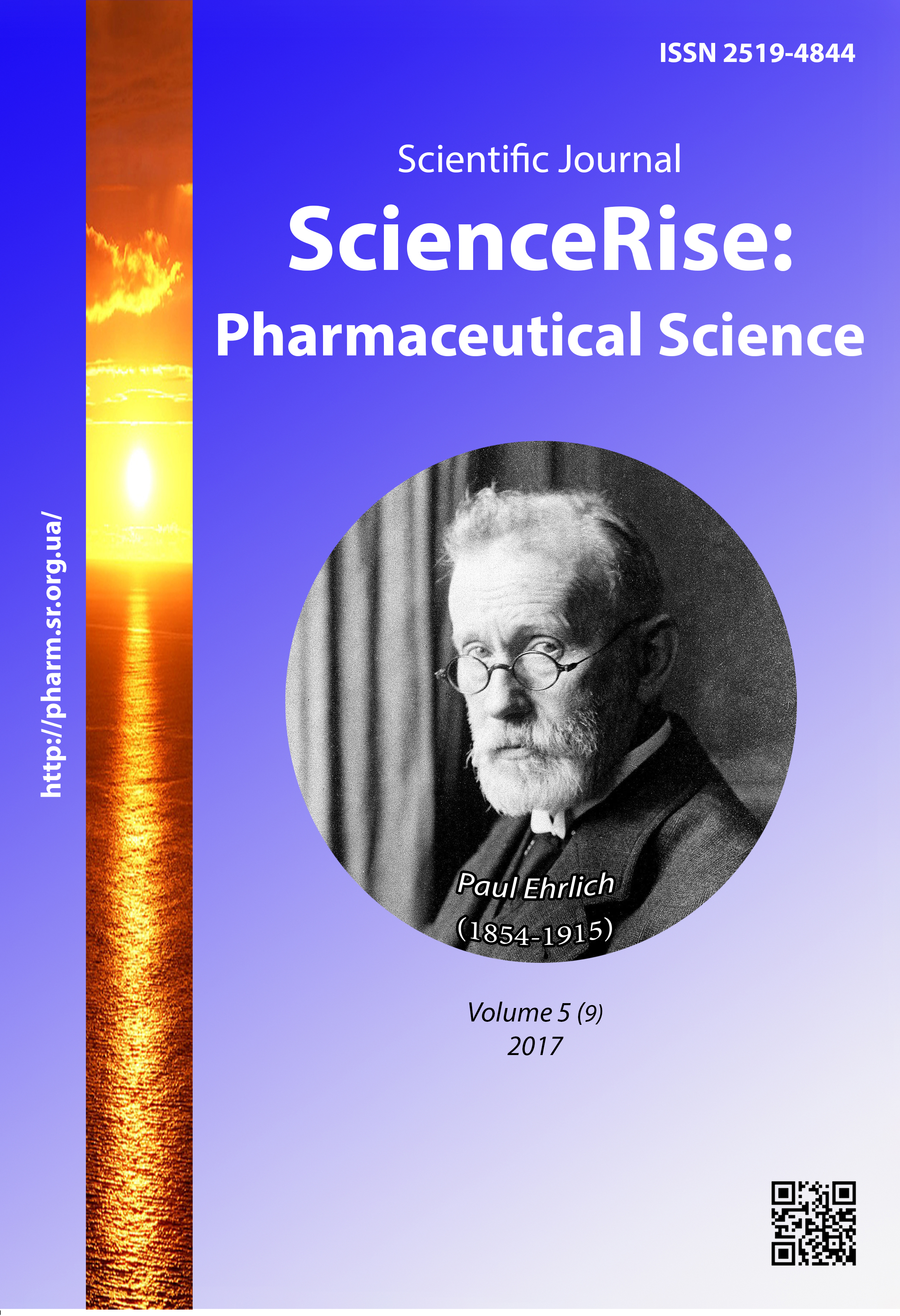Study of the inulin complex of dahlia root bulbs of Ken's flame species and its standardization
DOI:
https://doi.org/10.15587/2519-4852.2017.112581Keywords:
phytopolysaccharides, monosaccharides, fructose, glucose, inulin, pectins, acid hydrolysis, paper chromatography, spectrophotometry, DahliaAbstract
The literature data analysis has shown that phytopolysaccharides are perspective sources for study and development of active pharmaceutical ingredients, and can be used as new medicines or biologically active additives in future. Therefore, the obtained polysaccharide complex from the root bulbs of Dahlias “Ken's Flame” species is perspective for the further research and isolation of new pharmaceutical ingredients and substances.
Methods. The polysaccharide complex was obtained from the Dahlia’s tubers of “Ken's Flame” species. Paper chromatography method was used to identify monosaccharides of the polysaccharide complex. Quantitative determination of fructose in the complex was carried out by adsorption spectrophotometry using α-naphthol.
Results. Fructose and glucose were identified by standard paper chromatography after acidic hydrolysis of the polysaccharide complex in selected standard conditions. For the quantitative determination of fructose, the Dyshe reaction was used: with α-naphthol in acidic medium. The influence of boric acid and urea supplements on the optical absorption of fructose and glucose in the given reaction was studied. The polysaccharide complex hydrolysis kinetics was studied; conditions for reaction of fructose with α-naphthol in acidic medium were selected.
Conclusions. The standard conditions for the hydrolysis of the inulin complex were determined, followed by the identification of monosaccharides: fructose and glucose by paper chromatography method. The method of determination of fructose with α-naphthol in acidic medium for a polysaccharide complex obtained from the Dahlia’s tubers of “Ken's Flame” species was developed.
Experimental studies devoted to the inulin complex (IC) identification using chromatography, determined conditions for the reaction of fructose with α-naphthol in acidic medium, as well as conditions for IC hydrolysis, and IC standardization are presented in the article
References
- Patova, O. A., Golovchenko, V. V., Ovodov, Yu. S. (2014). Pektinovyie polisaharidyi: struktura, svoystva [Pectic polysaccharides: structure, properties]. Izvestiya Akademii Nauk. Seriya khimicheskaya, 9, 1901–1901.
- Huang, G., Chen, X., Huang, H. (2016). Chemical Modifications and Biological Activities of Polysaccharides. Current Drug Targets, 17 (15), 1799–1803. doi: 10.2174/1389450117666160502151004
- Kochetkov, N. A., Bochkov, A. F., Dmitriev, B. A. (1965). Khimiya uglevodov [Сarbohydrate chemistry]. Moscow: Khimiya, 619.
- Caregaro L., Menon F., Angeli P., Amodio P., Merkel C., Bortoluzzi, A., Alberino, F. et. al. (1994). Limitations of serum creatinine level and creatinine clearance as filtration markers in cirrhosis. Archives of Internal Medicine, 154 (2), 201–205. doi: 10.1001/archinte.154.2.201
- Kelly, G. (2008). Inulin-type prebiotics: a review: part I. Alternative Medicine Review, 13 (4), 315–330.
- Kelly, G. (2009). Inulin-type prebiotics: a review part II. Alternative Medicine Review, 14 (1), 36–55.
- Saeed, M., Yasmin, I., Pasha, I., Randhawa, M. A., Khan, M. I., Shabbir, M. A., Khan, W. A. (2015). Potential application of inulin in food industry: A review. Pakistan Journal Food Science, 25 (3), 110–116.
- Fontana, J. D., Grzybowski, A., Tiboni, M., Passos, M. (2011). Fructo-Oligosaccharide Production from Inulin Through Partial Citric or Phosphoric Acid Hydrolyses. Journal of Medicinal Food, 14 (11), 1425–1430. doi: 10.1089/jmf.2010.0273
- Kosasih, W., Pudjiraharti, S., Ratnaningrum, D., Priatni, S. (2015). Preparation of Inulin from Dahlia Tubers. Procedia Chemistry, 16, 190–194. doi: 10.1016/j.proche.2015.12.035
- Melanie, H., Susilowati, A., Iskandar, Y. M., Lotulung, P. D., Andayani, D. G. S. (2015). Characterization of Inulin from Local Red Dahlia (Dahlia sp. L) Tubers by Infrared Spectroscopy. Procedia Chemistry, 16, 78–84. doi: 10.1016/j.proche.2015.12.027
- Kupin, G. A., Ruvinskiy, O. E., Zayko, G. M. (2002). Issledovanie protsessa gidroliza inulina v soke iz topinambura [Studies of inulin hydrolysis in Jerusalem artichoke]. Izvestiya Vuzov. Pischevaya tehnologiya, 5-6, 77–78.
- Litvyak, V. V., Lukin, N. D., Mihaylenko, A. A., Kanarskiy, A. V. (2015). Morfologicheskie, strukturnyie i degidratatsionnyie svoystva inulina «Raftilingr» [Morphological, structural and dehydration properties of inulin «Raftilingr»]. Vestnik Kazanskogo tehnologicheskogo universiteta, 18 (1), 94–99.
- Zubaidah, E., Akhadiana, W. (2013). Comparative Study of Inulin Extracts from Dahlia, Yam, and Gembili Tubers as Prebiotic. Food and Nutrition Sciences, 4 (11), 8–12. doi: 10.4236/fns.2013.411a002
- Glibowski, P., Bukowska, A. (2011). The effect of pH, temperature and heating time on inulin chemical stability. Acta Scientiarum Polonorum Technologia Alimentaria, 10 (2), 189–196.
- Vistler, R. L. (1965). Metodyi himii uglevodov [Methods of carbohydrate chemistry]. Moscow: Mir, 512.
- The United States Pharmacopeia. The National Formulary. USP30-NF25 (2010). Rockville: The United States Pharmacopeial Convention, 4638.
- Ilyinska, N. I., Gontova, T. M., Kryukova, Ya. S., Matkovski, A. (2016). Pat. No. 107819 UA. Sposib oderzhannya Inulinu z bulb zhorzhini nimfeynoyi dlya medichnih tsiley [Method for obtaining inulin from dill vials for medical purposes]. МPK: C08B 37/18, A61K 36/28, A61K 31/733. No. u201512167; declareted: 08.12.2015; published: 24.06.2016, Bul. No. 12.
- Chushenko, V. N., Dihtyarev, S. I., Litvinenko, V. I., Ivanov, A. A. (2000). Biologicheski aktivnyie polisaharidyi rasteniy [Biologically active polysaccharides of plants]. Tehnologiya i standartizatsiya lekarstv, 2, 265–278.
Downloads
Published
How to Cite
Issue
Section
License
Copyright (c) 2017 Nonna Ilyinska, Tetiana Gontova, Valentina Chushenko, Petro Bezugly

This work is licensed under a Creative Commons Attribution 4.0 International License.
Our journal abides by the Creative Commons CC BY copyright rights and permissions for open access journals.








